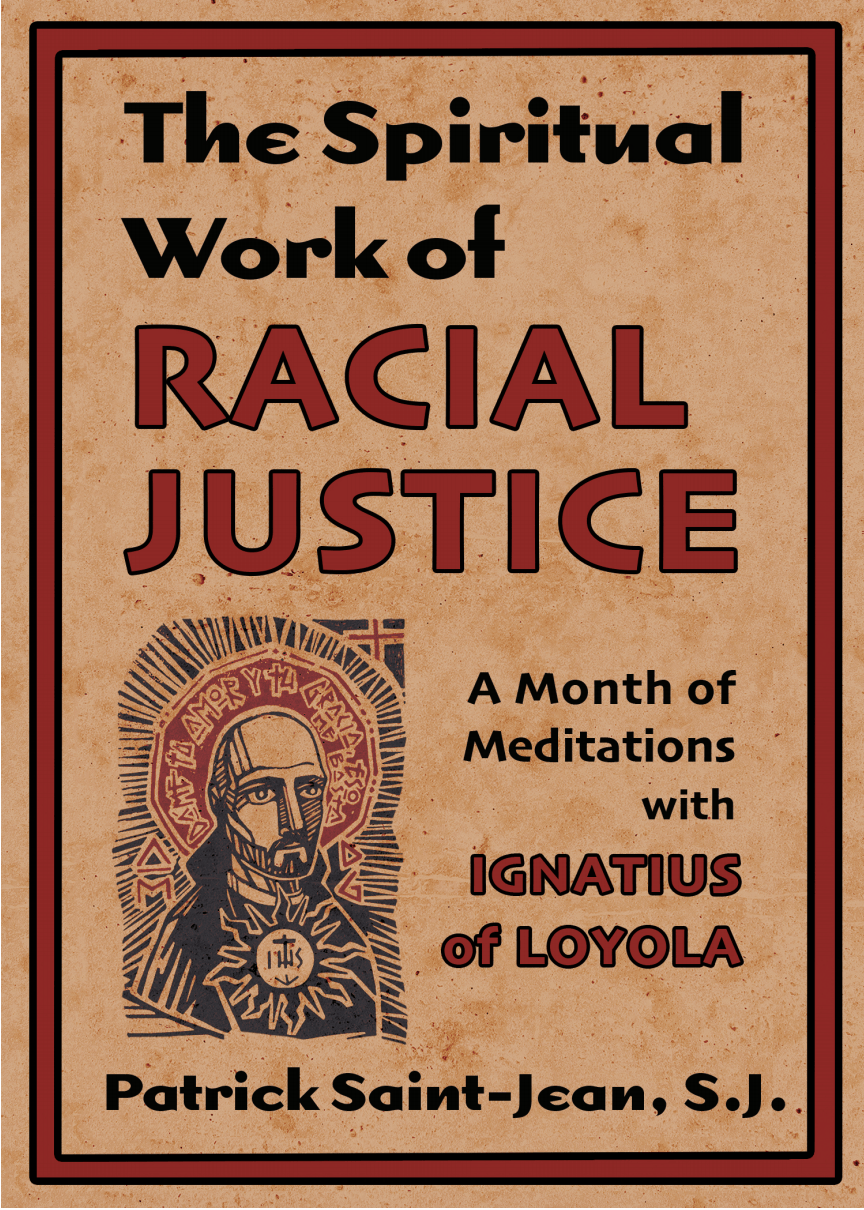The following is an excerpt from The Spiritual Work of Racial Justice: A Month of Meditations with Ignatius of Loyola, a new book by TJP contributor Patrick Saint-Jean, SJ.
As much as it pains me, I cannot escape the fact that Christianity was the cradle in which racism grew. Centuries ago, the church rationalized land theft from indigenous peoples and the enslavement of Africans with the belief that God was on the side of white Christians. In fact, the church taught, God had destined white people to remake the world in their own image. The theology that would one day be titled “Manifest Destiny” was already at work, as white Christians soothed their uneasy consciousness with their belief in their own God-given exceptionalism.
Ignatius spoke of false Christians as “poison,” “creeping daily like a gangrene.” I hope he would have been able to recognize the rottenness that took hold of Christianity during the centuries of colonization and conquest that led to the building of our world today. Theologian Kelly Brown Douglas has said that whites’ belief in their superiority is America’s original sin, spawning both slavery and the unjust treatment of indigenous people, both today’s racism and the fear and resentment of immigrants. This sin is the idolatry we discussed earlier; in effect, white Christian created their own false god—a white god—and this warped all their other beliefs.
And yet America prides itself on being a Christian nation. The Declaration of Independence based the rights it guaranteed in the fact that these are “God-given”; at the same time, it referred to the original inhabitants of North America as “merciless Indian savages.” America’s founders spoke passionately of the equality of “all men”—and yet the Constitution defined Black Americans as only three-fifths of a person. Clearly, to be “human” meant to be white (and male).
Until the nineteenth century, however, Jesus was usually portrayed as a dark-eyed, dark-haired Jew. But in the early 1800s, the American church was increasingly troubled by a number of issues. It struggled with the morality of taking more and more land from Native Americans, while at the same time, the tension around slavery was mounting. In these decades, white churches began printing and distributing pictures of a white Jesus. His image became a wordless source of unity and comfort for many troubled Americans.
Christian ministers also went beyond this nonverbal image, stating in no uncertain terms that the enslavement of human beings was justifiable from a biblical point of view. The Reverend James Henley Thornwell, a Harvard-educated scholar who memorized most of the entire Bible, regularly preached the message of white supremacy from his pulpit in Columbia, South Carolina, where he was the pastor in the years leading up to the Civil War. “As long as that [African] race, in its comparative degradation, co-exists side by side with the white,” Thornwell told his congregation in 1861, “bondage is its normal condition.” Christians need not feel guilty about enslaving other human beings, Thornwell said. “The relation of master and slave stands on the same foot with the other relations of life. In itself, it is not inconsistent with the will of God. It is not sinful.” The Bible, insisted Thornwell, sanctioned “slavery as any other social condition of man.”
After the Civil War, as Americans struggled with Reconstruction even as they worried about the growing number of Asian and Jewish immigrants, white Jesus became even more important to the identity of white folk. Artists began to portray the Savior as not only fair-skinned but also blond and blue-eyed. This was nonverbal propaganda; it allowed whites to absorb the message that the Divine was like them. White skinned people were good, like Jesus; brown-skinned people were dangerous and sinful, the opposite of Jesus.
Authors Skot Welch and Rick Wilson refer to white Jesus as “Plantation Jesus.” They make the statement that this concept of a white Jesus was what allowed good Christian folk to go to church on Sundays—and then put on the robes of the Ku Klux Klan the rest of the week and bomb, beat, torture, and murder Blacks. “Plantation Jesus was the reason that churches and Sunday schools sometimes dismissed early to participate in . . . lynchings, which happened in every American state except two.” Of course not all white Christians participated in lynchings, but the silence of the white church allowed the violence and murder to continue from 1880 to 1968. As historian Jemar Tisby has reminded us, “The refusal to act in the midst of injustice is itself an act of injustice. Indifference to oppression perpetuates oppression.”
Many white Christians did not identify themselves with the Ku Klux Klan, but they too worshipped a form of white Jesus. They implicitly believed that because Jesus was white, whites had the corner on God. Meanwhile, from its beginning, KKK members considered themselves good Christians. One Klan leader stated, “As the Star of Bethlehem guided the wise men to Christ, so it is that the Klan is expected more and more to guide men to the right life under Christ’s banner .” In the opening prayer of Klan rituals, the order proclaimed: “The living Christ is a Klansman’s criterion of character.” Perhaps Ignatius had something like these so-called Christians in mind when he said, “Charity and kindness unwedded to truth are not charity and kindness, but deceit and vanity. “
As the Civil Rights Movement dawned, white Jesus was still very much present. On Sunday, May 14, 1961, a crowd of angry white people in Alabama attacked a Greyhound bus carrying Freedom Riders (protestors against segregationist laws). The mob threw rocks and bricks through the windows and then tossed a firebomb through a broken window. As smoke and flames filled the bus, the attackers barricaded the door. “Burn them alive!” someone in the crowd shouted. A few weeks later, Montgomery’s most prominent pastor, Henry Lyon Jr., denounced the Freedom Riders. “Ladies and gentlemen,” he announced at a community gathering, “for fifteen years I have had the privilege of being pastor of a white Baptist church in this city. If we stand a hundred years from now, it will still be a white church. I am a believer in a separation of the races, and I am none the less a Christian.”
Lyon waited for the applause to die down before he continued: “If you want to get in a fight with the one that started separation of the races, then you come face to face with your God. The difference in color, the difference in our body, our minds, our life, our mission upon the face of this earth, is God given.” Not all white churches took such an outspoken and overt stand in support of racism, but as Jamar Tisby points out, “At a key moment in the life of our nation, one that called for moral courage, the American church responded to much of the civil rights movement with passivity, indifference, or even outright opposition.”
You would think that Black people would have unanimously turned away from Christianity. Instead, many Black people, including my own ancestors, went directly to the Jesus of the Gospels. They found there a Jesus who looked like them—a person with brown skin, a victim of oppression. They discovered a Jesus whose message was love, affirmation, and freedom, a Jesus who came to take his stand with any who are oppressed.
In the historical Jesus, we find the embodiment of God’s love for justice. In his life on earth, we come face to face with a Divine Being who experienced the pain of rejection, of poverty, of political oppression—and yet rose above them all with his message of liberation and love. This is the true message of Christ. “Racism is the ultimate denial of the Gospel,” said Bishop Desmond Tutu, “and it cannot be but that all believers would oppose vehemently this false gospel that would have people place their hope of salvation in a pseudo-gospel.”
“Above all,” Ignatius tells us, “remember that God looks for solid virtues in us, such as patience, humility, obedience, abnegation of your own will—that is, the good will to serve God and our neighbor in God.” Ignatius points us to a spirituality that has nothing to do with white Jesus, a false god of superiority, intolerance, and injustice. In the Second Week of the Spiritual Exercises, Ignatius asks us to focus on humility. He defines humility at its deepest, most authentic level as total identification with Jesus:
I so much want the truth of Christ’s life to be fully the truth of my own that I find myself, moved by grace, with a love and a desire for poverty in order to be with the poor Christ; a love and a desire for insults in order to be closer to Christ in his own rejection by people; a love and a desire to be considered worthless and a fool for Christ, rather than be esteemed as wise and prudent according to the standards of the world.
These words us challenge us with this question: Can we see Jesus in the lives of those who have been oppressed? Are we willing to serve the true Jesus, a person of color?


